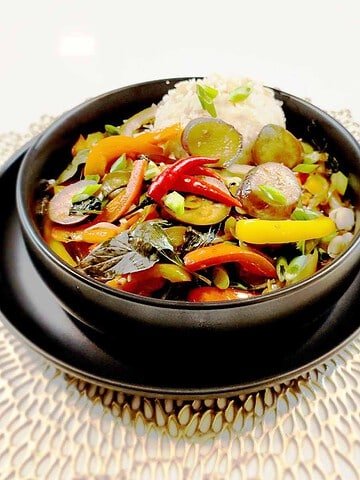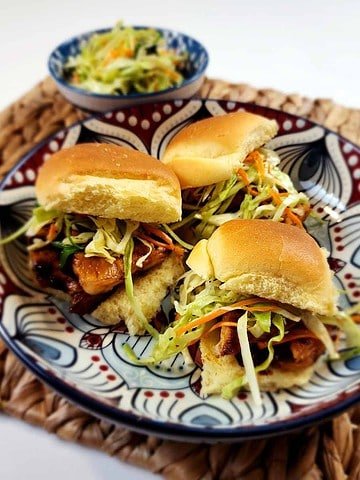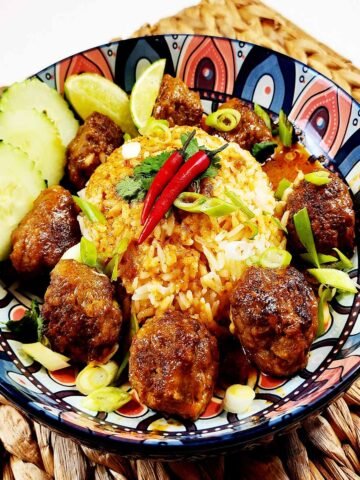
When dining at a Thai restaurant, you'll often see a small spice tray. It holds essential condiments like sugar, fish sauce, chili flakes, and vinegar. These enhance the dining experience. These items are pivotal to Thai cuisine, enabling diners to personalize their dining experience. Let's delve deeper into each condiment and explore how they contribute to the complex layers of flavor in Thai dishes:
First Jar in The SpiceTray Sugar
Enhancing Sweetness and Balance:
Sugar is essential in Thai cuisine, serving to add sweetness and balance and enhance flavors. By adjusting sugar levels, diners can finely adjust the overall taste profile of dishes, effectively moderating spiciness to achieve a harmoniously balanced and enjoyable flavor experience with every bite.
- Green Papaya Salad (Som Tum): Sprinkle sugar over green papaya salad to balance the heat from chili flakes and the tanginess from lime juice, "Creating a balanced combination of sweet, spicy, and sour flavors."
- Curries and Stir-fries: In curries like Massaman or stir-fried dishes, sugar softens the spiciness of chili and balances the savory richness of coconut milk or fish sauce. For instance, in a Massaman curry, a sprinkle of sugar can mellow the heat and enhance the overall flavor profile.
Second Jar In The Spice Tray: Fish Sauce
Enhancing Umami and Salinity:
Fish sauce, crafted from fermented fish and salt, is prized for its ability to deepen flavors and impart a savory umami richness to dishes. It will add a salty and slightly tangy note that complements and enriches other ingredients without overpowering them:
- Stir-fries and Noodle Dishes: Drizzle fish sauce into stir-fries or noodle dishes to infuse them with a complex depth of flavor.
- Marinades and Soups: It serves as a key ingredient in marinades and soups, enhancing the savory base and adding layers of complexity.
Third Jar in The Spice Tray: Chili Flakes
Adding Heat and Complexity:
Chili flakes or crushed chilies are essential for imparting heat and complexity to Thai dishes, empowering diners to tailor spice levels to their preferences. By adjusting the amount of chili flakes, diners can precisely control the intensity of heat, enriching the dining experience with nuanced layers of spiciness and intricate flavor complexity.:
- Spicy Salads (Yam) and Noodle Soups: Sprinkle chili flakes over salads or noodle soups to intensify flavors and add a fiery kick.
- Stir-fries and Curries: Use them in stir-fries or curries to impart depth and complexity, balancing other flavors.
Forth Jar In The Spice Rack: Vinegar with Sliced or Crushed Chilies
Balancing Acidity and Freshness:
Vinegar infused with sliced or crushed chilies brings a tangy brightness to dishes, effectively balancing richness and enhancing freshness. By incorporating vinegar with chilies, diners can elevate dishes with a vibrant acidity that harmonizes with other flavors, creating a well-rounded and flavorful dining experience.
- Seafood and Meat Dishes: Use it as a dipping sauce for seafood or drizzle it over grilled meats to add a refreshing contrast.
- Salads and Noodle Soups: Incorporate it into salads or noodle soups to brighten flavors and cut through richness.
Using The Spice Tray To Controlling Your Dining Experience:
By understanding how to utilize these condiments, diners are empowered to personalize their dining experience at Thai restaurants. Whether adjusting sweetness with sugar, enhancing umami with fish sauce, adding heat with chili flakes, or balancing acidity with vinegar and chilies—these condiments offer a spectrum of options.Experimenting with combinations reveals new flavors and deepens appreciation for Thai gastronomy's intricate taste layers.
Expert Insights and Tips:
Thai chefs emphasize the importance of balance in Thai cooking. Chef Nongkran Daks advises, "Each ingredient on the spice tray is carefully selected to create flavor harmony. Start with small amounts and adjust gradually to achieve the perfect taste profile."
Cultural Significance of the Spice Tray:
In Thai culinary culture, the spice tray is more than just a collection of condiments. It symbolizes hospitality and respect for individual taste preferences. It embodies the Thai philosophy of balancing flavors—sweet, salty, spicy, and sour—to create harmonious and satisfying meals. The presence of these condiments on every table encourages diners to engage actively with their food, transforming each meal into a personalized culinary experience that celebrates Thailand's rich culinary heritage.
Health Benefits:
These condiments offer more than just enhanced flavor. They also provide health benefits. Chili flakes contain capsaicin, known for its metabolism-boosting and anti-inflammatory properties. Vinegar with chilies aids digestion and may help regulate blood sugar levels. Fish sauce, known for its saltiness, provides essential amino acids and contributes to overall nutritional balance when used in moderation. Additionally, by incorporating these condiments, you're not just enhancing your dining experience; you're also taking care of your health.
Conclusion:
The spice tray at Thai restaurants isn't merely decorative; it's a gateway to exploring Thai cuisine's nuanced flavors. Diners use sugar, fish sauce, chili flakes, and vinegar with chilies to customize their dining experience. Whether savoring classics or exploring new favorites, these condiments embody Thai culinary tradition, offering a journey of taste and exploration.
In essence, these condiments empower diners to transform each meal into a personalized culinary adventure. Here, every flavor is enhanced, and every bite tells a story of Thailand's rich gastronomic heritage.






Leave a Reply